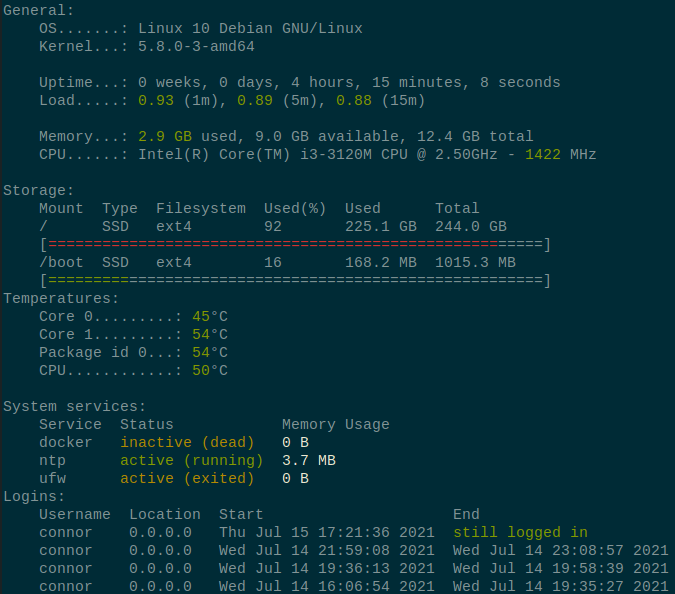6 releases
| 0.2.1 | Jun 28, 2022 |
|---|---|
| 0.2.0 | Aug 15, 2021 |
| 0.1.3 | Aug 9, 2021 |
| 0.1.1 | Jul 16, 2021 |
#1801 in Command line utilities
38KB
730 lines
sysstatus
A small fast tool to get an overview of the system including load, storage usage, temperature and services.

Installation
Source
- Clone the repository
git clone git@github.com:scratchcat1/sysstatus.git - Move into the repository
cd sysstatus - Build with
cargo build - Run with
cargo runorcargo run --release - (Optional) Use a different config file using
cargo run -- -c /path/to/config.json
Options
sysstatus 0.1.1
USAGE:
sysstatus [FLAGS] [OPTIONS]
FLAGS:
--default-config Create a default config file and then exit
-h, --help Prints help information
-V, --version Prints version information
OPTIONS:
-c, --config-file-path <config-file-path>
Path to configuration file. Default is $HOME/.config/sysstatus/config.json
Configuration
sysstatus requires a configuration file to run, by default looking for $HOME/.config/sysstatus/config.json.
To specify a config file manually use sysstatus -c /path/to/config.json.
A default config can be generated with sysstatus --default-config.
Colors
Colors must use values which deserialise to a colored::Color, see the enum here.
Valid examples include "Black", "BrightCyan" and { "TrueColor": { "r": 3, "g": 4, "b": 255 } }
Conditional Colour
ConditionalColour allows text colours to be selected dynamically depending on the value of the attribute. Each ConditionalColour has a default colour and zero or more ColourLevel resulting in a definition as follows:
{
"default_colour": "Green",
"levels": [
{
"min": 0.5,
"colour": "Yellow"
},
{
"min": 0.8,
"colour": "Red"
}
]
}
ConditionalColours are evaluated by selecting the furthest colour down the list for which the comparison value is greater than or equal to min. The min of each level must increase as the list is traversed or behaviour is undefined.
In the example:
- 0.1 => Green
- 0.49 => Green
- 0.5 => Yellow
- 0.7 => Yellow
- 0.8 => Red
- 10.0 => Red
Example config (with explanations)
{
// [Optional] Configuration for general overview
"general_info": {
// ConditionalColour for load average. Comparison value = load / cores.
"load_avg": {
"default_colour": "Green",
"levels": [
{
"min": 0.5,
"colour": "Yellow"
},
{
"min": 0.8,
"colour": "Red"
}
]
},
// Conditional Colour for memory usage. Comparison value = used / total.
"memory": {
"default_colour": "Green",
"levels": [
{
"min": 0.7,
"colour": "Yellow"
},
{
"min": 0.9,
"colour": "Red"
}
]
},
// ConditionalColour for CPU frequency. Comparison value = CPU frequency in MHz.
"cpu_frequency": {
"default_colour": "Green",
"levels": [
{
"min": 2000,
"colour": "Yellow"
},
{
"min": 2400,
"colour": "Red"
}
]
}
},
// [Optional] Configuration for the storage bars
"storage": {
// ConditionalColour for colouring the usage bars of storage usage. Comparison value = used / total.
"usage_colouring": {
"default_colour": "Green",
"levels": [
{
"min": 0.8,
"colour": "Yellow"
},
{
"min": 0.9,
"colour": "Red"
}
]
},
"exclude_prefixes": [
"/var/lib/docker/"
]
},
// [Optional] ConditionalColour for temperature. Comparison value = temperature of component.
"temperature": {
"default_colour": "Green",
"levels": [
{
"min": 70,
"colour": "Yellow"
},
{
"min": 85,
"colour": "Red"
}
]
},
// [Optional] Map of service names to service configurations
// The ending .service is not needed.
"services": {
"docker": {
// ConditionalColour for memory usage of service. Comparison value = memory usage in bytes.
"memory_usage": {
"default_colour": "White",
"levels": [
{
"min": 2000,
"colour": "Yellow"
},
{
"min": 2400,
"colour": "Red"
}
]
}
},
"ntp": {},
"ufw": {}
},
// [Optional] Configuration for last login section.
"last_login": {
// Optionally only include logins which occur before a certain time.
// Accepts any value which `last --since` accepts e.g. `+5days`, `yesterday`.
"since": "yesterday",
// Mapping of usernames to fetch the last logins for to the configuration for that user's last login.
"users": {
"pi": {
// Optionally limit the maximum number of logins shown of the user.
"max_lines": 4
},
"root": {
// Optionally set the colour of the username.
"username_colour": "Red"
}
}
}
}
FAQ
Why do all my systemd services show a memory usage of 0B?
On some systemd installations memory accounting is disabled by default. You can enable it by uncommenting or setting
DefaultMemoryAccounting=yes
in /etc/systemd/system.conf and then running systemctl daemon-reexec.
See this stackoverflow question for more details.
Alternatives
- motd - "Collection of my 'Message of the Day' scripts" by yboetz
- rust-motd - "Beautiful, useful MOTD generation with zero runtime dependencies" by rust-motd
Acknowledgements
This program is partly derived from rust-motd particularly in regards to formatting and handling last login parsing.
Dependencies
~6–15MB
~174K SLoC